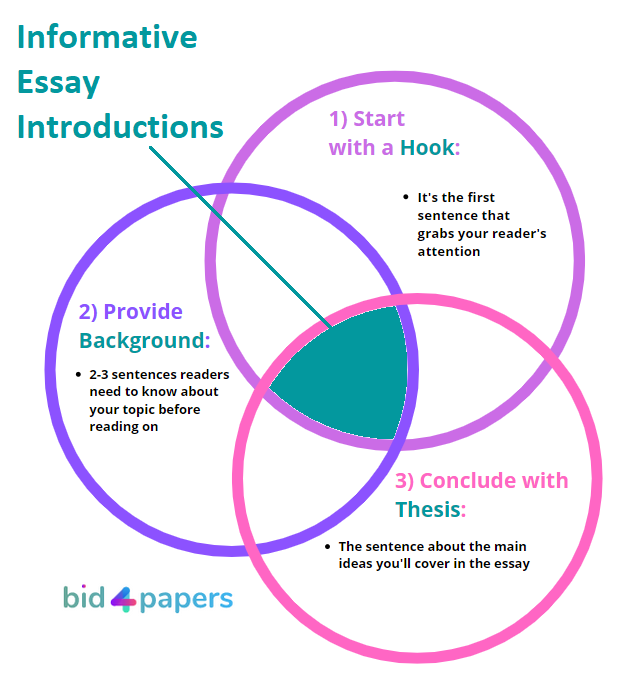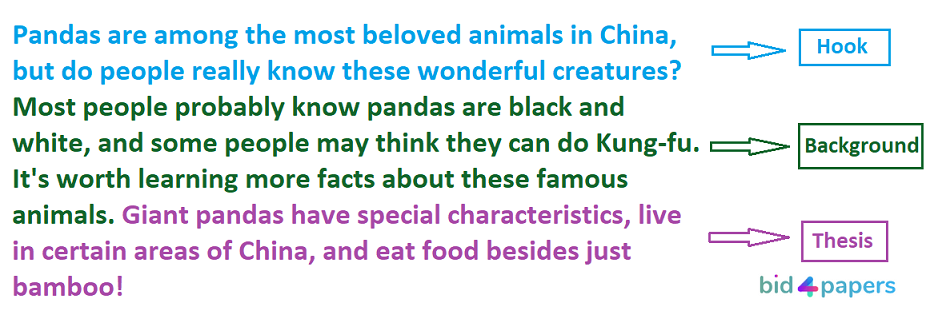
How to Start an Informative Essay
- Grab attention.
- Introduce and explain a topic.
- State a thesis.
With so many articles and blog posts about essay introductions, most students still want to see detailed guides on writing intros for specific essay types. We’ve got them covered:
Here’s the step-by-step guide on how to start an informative essay. (For other intro types, feel free to check the instructions from our professional writers on how to start persuasive and personal essays. The ultimate guide on writing essay intros is also available: Here it is.)

So, How to Start an Informative Essay
We hope you’ve already checked our ultimate guide on informative essays and learned the purpose of this writing:
It educates the reader. An author provides terms, facts, and data about a particular topic/issue, thus explaining it to the audience. When writing an informative paper, you don’t argue or persuade but share the facts, compare them, explain how something works, etc.
The introduction of such essays is essential: It helps the audience understand whether they want to continue reading and learn more about the topic.
The Role of Intros in Essays
The essay introduction is the first paragraph of your paper, aimed at presenting and explaining the issue so that people would like to continue reading and learn more.
Below are three main jobs informative essay introductions do:
- Introduce the topic and explain why it’s critical.
- Highlight the essay’s main ideas.
- State a thesis.
To get people interested in reading your essay, it’s critical to introduce the topic so they would understand why it’s worth learning more about it. For that, you’ll need to capture their interest, state the issue with some background information, and explain (briefly!) what you’re going to cover in the essay.
No matter how brilliant your informative essay is, its poor introduction may prevent the audience from reading it. A teacher grading your essay may underestimate your work if it starts with a weak first paragraph.
The Elements of Informative Essay Introduction
Now that you know why essay intros are so critical, it’s time to learn the essential components you’ll need to include in the first paragraph of your informative essay to make it do the job:
Your essay introduction will need a hook, background information, and a thesis statement.

- Hook: the first sentence that grabs your reader’s attention
- Background: 2-3 sentences readers need to know about your topic before reading on
- Thesis: the sentence about the main ideas you’ll cover in the essay
Make all three elements concise and clear. Remember that it’s just the first paragraph of your essay: 4-5 sentences will be enough to fulfill the task.
And now, for more details on each element in your informative essay introduction:
Hook
A hook for essays is the first sentence that grabs attention and motivates the audience to keep reading. Hook types are many, and the most relevant ones for informative writing are an interesting fact, a question, or a statistic.
Let’s say, you write an informative essay about pandas. That’s what your hook sentence could be:
- An interesting fact: “A newborn panda is 1/900th the size of its mother.”
- A question: “Pandas are among the most beloved animals in China, but do people really know these wonderful creatures?”
- A statistic: “In 1970, there were only about 1,000 giant pandas left on earth.”
Once your hook is ready, use some linking words to make a natural transition to the topic. It will make your writing sound logical for readers to follow.
Background Information
The background information comes after your hook sentence: It should relate to the topic of your informative essay and naturally flow into your thesis.
Let’s continue with pandas. The background information in your introduction could sound like that:
- “Most people probably know pandas are black and white, and some people may think they can do Kung-fu. It’s worth learning more facts about these famous animals.”
Thesis Statement
This element is a must-have for all essay types. It comes at the end of your introductory paragraph, explaining and summarizing the issue you’ll explain in the essay body.
Here goes our “panda” thesis:
- “Giant pandas have special characteristics, live in certain areas of China, and eat food besides just bamboo!”
It’s the heart of your essay, providing a reason to read it. A strong thesis statement should specify the topic (pandas) and the main points (sub-topics) you’ll describe in your essay to support it (characteristics, areas in China, and food).
Let’s see the complete essay introduction we’d get if we wrote about pandas:

A giant panda thank goes to Mr. S and his YouTube channel!
Writing Essay Intros, Step by Step
The below tips will help you write informative essay introductions faster. Since you already know the elements to include there, try the following tactics to ease the process:
1) Know your topic
Sometimes it’s a teacher assigning a specific topic for your informative essay. However, the common practice today is to let students choose topics for their academic papers themselves. In this case, it would help if you wrote about something you love, understand, and enjoy investigating.
Don’t hurry up to introduce your topic. It’s okay to write an essay outline and body first, and then come back to writing the first paragraph with a proper introduction of what you’ve covered in the text.
2) Grab attention
When you have an informative essay assigned in school or college, you imagine a teacher as its one and only reader. You understand they will keep reading your work anyway because they have to give you a grade. Why not change the perspective?
Try to imagine you write for a broader audience. What hook would you try to grab their attention from the first sentence and engage them to keep reading?
Start your essay introduction with a sentence that gets the reader interested in the topic. As already mentioned, it can be some unexpected fact, catchy question, or surprising statistic.
3) Present your topic
You need to tie a hook with a thesis statement of your essay so the whole introduction would look and sound logical. A few sentences between these two elements, where you present the topic, serve for that.
Try drawing on the point you made in the hook and connect it to the scope of your essay.
4) Explain or clarify the topic
Providing readers with a little bit of background on the topic allows them to better understand the issue. You don’t need to go into extreme detail, just give a short explanation of the topic.
Your background information here should be concise and clear.
- Avoid sweeping generalizations or dictionary definitions, don’t write anything like, “All people know that…” or “According to the dictionary.”
- Say no to direct statements like, “In this essay, I will write about..,” “I’m going to tell you about,” “My essay is about,” etc.
- Never suggest you’re not familiar or certain with the topic. Avoid phrases like, “I can’t be certain, but…”
“I think” is also wrong to use in an informative essay. Its purpose is to inform, not share your opinion.
5) Conclude by stating your thesis
The thesis statement is the central idea of your whole essay: It tells readers what to expect and compels them to keep reading.
State three main claims you’re going to make in your paper — they will be subtopics for each of your three body paragraphs. Remember the thesis statement in the above example with pandas?
- “Giant pandas have special characteristics, live in certain areas of China, and eat food besides just bamboo!”
Three subtopics here are:
#1 paragraph: What special characteristics describe a giant panda?
#2 paragraph: Where do giant pandas live?
#3 paragraph: What do giant pandas eat?
And please don’t include any supporting evidence or quotes in essay introductions: You’ll add them later throughout the body.
In a Word
So now that you have a step-by-step instruction on how to start an informative essay, we hope the writing process will go faster. Everything is easy:
- Grab a reader’s attention with a hook.
- Introduce a topic and provide a little background on it.
- State a thesis, telling about what you’ll cover in the essay.
Still in doubt? Don’t hesitate to ask Bid4Papers for help with essays!